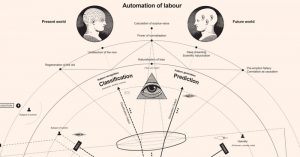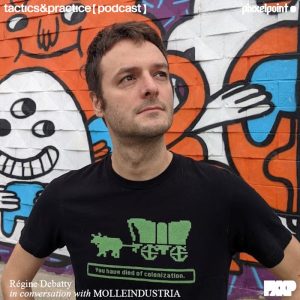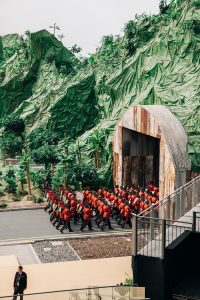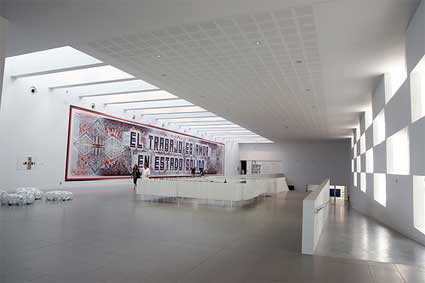 LABoral (inside) mural by Mark Titchner. Image courtesy of LABoral
LABoral (inside) mural by Mark Titchner. Image courtesy of LABoral
Together with Erich Berger and Laura Baigorri, Daphne Dragona curated Homo Ludens Ludens, an exhibition about play in contemporary culture and society which runs until September 22 at LABoral, Spain. I’ve been blogging the exhibition over the past few days but i wanted to end the coverage with a couple of questions to Daphne.
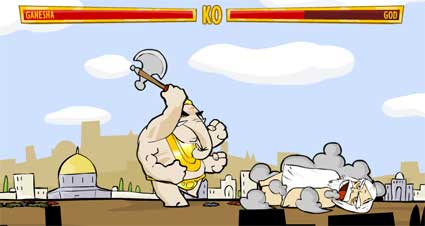
Daphne Dragona is an independent new media arts curator and organiser, based in Athens with a special interest in the game arts field. She was the Programme Curator of Gaming Realities (Medi@terra, International Art and Technology Festival) which took place in Athens in 2006, and the Associate Curator of Gameworld which was hosted in Laboral in 2007. She has been involved as an organiser or as a participant in different new media events and since 2004 she is also collaborating with the International New Media Collective Personal Cinema.
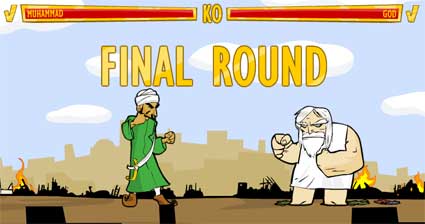 Molle Industria, Faith Fighter
Molle Industria, Faith Fighter
Following Gameworld and Playware, Homo Ludens Ludens is the last episode of a trilogy dedicated to the world of game. How different is HLL’s take on the theme of games and play?
We wanted Homo Ludens Ludens to embrace the previous concepts and summarize them somehow. To do this we needed to take in a way a step back, to look into play rather than games, to locate play’s role and significance into the different sections of our society and culture. The two previous exhibitions, Gameworld and Playware focused respectively on the creativity of gaming art and on the playfulness of interactive art. Homo Ludens Ludens tried to locate and present play as a power and a medium that is embodied in different sections of our lives, that can ask questions, reveal facts and bring changes.
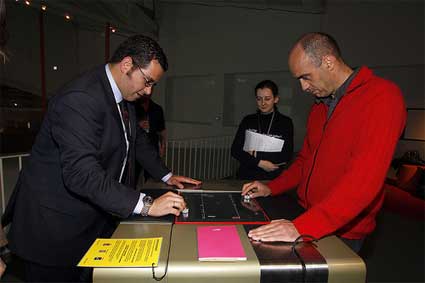 PainStation. Image credit: LABoral/Enrique G. Cárdenas
PainStation. Image credit: LABoral/Enrique G. Cárdenas
HLL presented 4 different themes: previous art movements which incorporated play in their discourse, play in everyday life, contents which invite to reflect on political and social issues and finally an introspective look on games and video games. Why did you decide to adopt such a broad approach?
Well, truth is that there are much more themes being discussed. We referred to these 4 categories at some point because the need appeared, as it happens for all exhibitions, to speak of a particular kind of structure. But in reality we were against the idea of grouping and categorising. Works can be categorised according to this scheme or some other schemes. The form of the exhibition is quite fluid actually, with no rigid clusters and units. To come back to your question, yes the theme is broad, but the issue of play in our digital times is huge anyway. Naming the event Homo Ludens Ludens was in a way an intro for a broad approach. Huizinga was already talking about the diffusion of play within culture back in the late 30s. We wanted to explore and present how things have changed, flourished and altered since then; to bring in as many aspects as possible through our exhibition and our conference. There have been a lot of misunderstandings regarding play nowadays: for instance, you speak about play and everyone things you refer to videogames, you refer to play and the issue is considered merely joyful, entertaining and lacking content. We wanted to escape from this, to present play’s multifaceted character and raise consciousness about it. So, the approach could have been even broader, but maybe then the risk of its good presentation and perception would be higher.
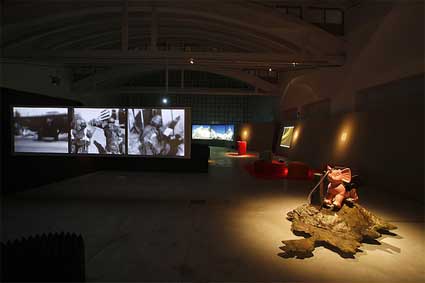 Image courtesy of LABoral/Enrique G. Cárdenas
Image courtesy of LABoral/Enrique G. Cárdenas
Which strategies did you adopt to have works which have very different backgrounds and characteristics (the interview with Muciunas, the installation levelHead, the Objects of Desire chase, etc.) cohabit and dialog with each other? You and your fellow curators Erich Berger and Laura Baigorri must have met with many challenges when preparing such a big and multi-faceted show. How did you manage to keep your head(s) above the water?
I would not really speak of strategies. Let’s say that we located the areas of our interest on one hand, and works we consider interesting and inspiring on the other. We knew that we wanted to have a show that would be playful and critical at the same time. The criterion for all cases of works was not their form, for instance to be game applications as it happens in most game art shows, but rather their playfulness, their ludic mode and the ability to express different situations and notions through it. There were no constraints regarding any types of works – the exhibition was to be explored as a territory, a playground of various contemporary magic circles. This is maybe where the challenge and the difficulty was: trying to avoid usual paths and groupings that exhibitions tend to follow and still aiming to have a perceivable context and content. This is how we came up with dialogues and adjoining of certain works that were implied but not explained or framed. I believe that this kept the flow much smoother and more open.
So this way, for example, Wegman‘s dogs could go next to Stockburger‘s Tokyo gamers to show play’s omnipresence and utter seriousness; Ludic Society‘s chase based on the desires of particular objects and Savicic’s wifi map of gijon as read by his special corset could be adjoined by a magnified copy of Debord‘s psychogeographical map of Paris; Klima‘s pink elephant on the war of Afghanistan could sit next to Sanchez’s Atari modification for the civil war of Peru.
Regarding the references to the old movements of the fluxus and the situationists we felt like we ought to include them, not only as a “tribute” to them but also as an additional element for the audience to perceive the contemporary works we present. For instance, it is important to see that certain notions that are presented in this show such as those of the transdisciplinarity, the appropriation, the detournement, the idea of highlighting the importance of everyday life as opposed to art, they all have their roots way back, in important modern movements.
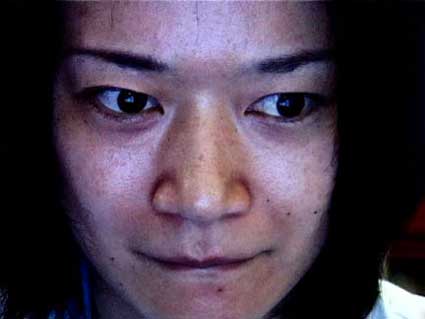 Axel Stockburger, Tokyo Arcade Warriors – Shibuya (2005)
Axel Stockburger, Tokyo Arcade Warriors – Shibuya (2005)
Many of the works on show at HLL demonstrate a keen observation of the rules and mechanisms of commercial games but do you think that the opposite is true? Have you ever noticed any interest from the commercial scene for what artists are doing with the game medium?
My understanding is that they do follow what happens in terms of creativity. The innovations and the approaches that are often introduced by artists and independent creators are of their interest either in terms of design, content or programming. And they do tend to hire artists often as part of their team, which makes sense of course. But on the other hand, judging from my experience, game companies still hesitate to support game art exhibitions, festivals and conferences. The commercial and the independent/artistic scene have not really merged yet. Probably they are not meant to merge, if we take what happened with cinema as an example. Different works and productions attract different audiences. Not a lot of gamers go to game art exhibitions for instance. The audience for these shows is mainly people interested in the arts and the technology. But at the end, it all works perfectly well for the industry as games are assigned new roles and are being accredited new values. This is the tricky point. As Auriea Harvey and Michael Samyn had said, how about if the artistic / independent gaming scene at the end becomes the alibi for the commercial one to keep its character intact?
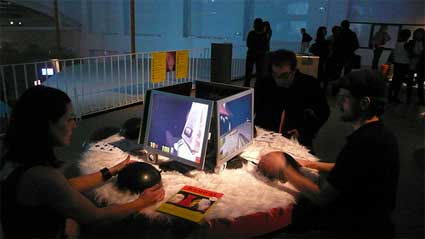 France Cadet, SweetPad
France Cadet, SweetPad
If i’m not wrong, you distinguish play from game. Can you explain us what makes them different from each other?
Yes, we tried to make this distinction visible in Homo Ludens Ludens, although there is no “formal” differentiation between the two terms and there is of course a lot of overlapping. In reality, it is easy to describe games but rather difficult to frame play.
I would say play reflects more the idea, the notion, the vivid and spontaneous basis for the action as well as its relation to fantasy, whereas games are closed systems and environments governed by rules which demand discipline and a constraint space and time. Play is in a way the presupposition for the games that are its expressions and forms.
Play as a notion is much more open and therefore it may even embrace elements that come in opposition with a game’s structure. For instance play has no death or end; but games do, otherwise there s no meaning into it. Or think of cheating. While it can destroy a game by breaking its rules, it is still a part, an act of play. On the same line, while any game forms hierarchies, play creates interrelations between them.
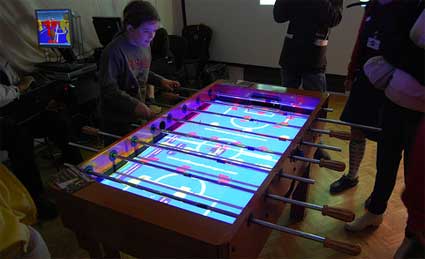 MIT Lab – Drew Harry, Dietmar Offenhuber, Orkan Telhan Stiff People’s League
MIT Lab – Drew Harry, Dietmar Offenhuber, Orkan Telhan Stiff People’s League
It is all up to the play instinct I guess. We can be playful anytime anyplace, not only through games. Games are basically a construction which is made possible because of this playfulness that already exists in any aspect of life.
Nowadays, with the explosion of the videogame industry games have also become a product, a commodity and a subject of control. Accordingly, play became work and life itself started looking more like a complicated game environment. So the question is what happens with the notion of play at such times? This is really interesting: how we have been led from the total invasion of play that the situationists were dreaming of to the gamespace phenomenon Wark describes.
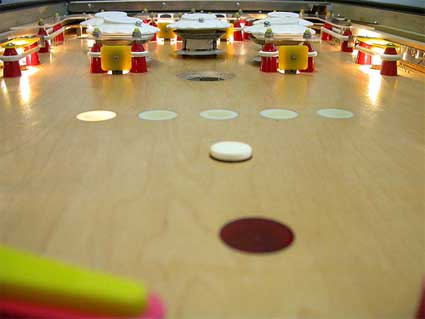 Martin Pichlmair & Fares Kayali Bagatelle Concrete
Martin Pichlmair & Fares Kayali Bagatelle Concrete
What is your personal relationship with video games? Are you a gamer yourself?
I mostly enjoy following what s happening in the online virtual worlds and trying out practices and applications by the independent and artistic scene. I also do try to keep up with the commercial games popping up but sometimes this is not so easy in terms of time and energy. Generally, however, if you ask me about the last months, I must say that -maybe influenced by homo ludens ludens- I also got carried away and inspired by other types of play; from children’s make believe play to play being approached by philosophy as a tool for political change… This practically means that I really liked playing a lot with my 2 year old niece on one hand and reading Agamben and Vaneigem on the other. It was quite a weird combination now that I think about it…
Thanks Daphne!

